How to root a violet from a leaf correctly?
Violet (Saintpaulia) is liked by flower growers due to the charming flowers of various colors and a convenient way of propagating them. You can get a young Saintpaulia bush with just one leaf.
Content:
- Description of violets and the best varieties
- Conditions for growing flowers
- Preparing soil, dishes and rooting cuttings
- Possible growing problems
Description of violets and the best varieties
The Uzambara violet (Saintpaulia) belongs to the Gesneriaceae family. It is a perennial tropical plant. It has been grown in Europe for over 200 years. There are about 20 types of violets that grow in natural conditions. In addition, hundreds of varieties have been created that differ in the shape of the flower (double, semi-double, simple), their color, shape and color of the leaves.
Saintpaulia reaches a height of no more than 30 cm, bushes with a height of about 20 cm are often found.
The leaves are collected in a root rosette. The edges of the sheet plate differ depending on the grade and can be flat or wavy. Leaves of all varieties are covered with long soft villi. Light veins are visible on the leaf. The color is green, with white or yellow blotches.
Saintpaulia flowers are what thousands of flower lovers adore them for. They are monochromatic, there are motley ones. The color scheme includes white, pink, purple and blue along with all sorts of shades.
Types of Saintpaulias:
- Classic with five rounded petals.
- Terry and semi-double with a large number of petals.
- Star-shaped with petals pointed to the edge.
- Fantasy with bright specks and spots on the petals.
- Bordered with a stripe of a different color along the edge of the petal.
- Chimeras with striped petals.
Varieties of uzambar violets:
- Belley Snowden, whose white flowers are collected in a hat.
- Arctic Frost is unpretentious in care, but does not tolerate direct sunlight.
- Silver Romance is a terry variety with white and pink petals and a white and yellow border around the edge.
- Winter Parasol blooms for a long time with pink flowers with a lilac border.
- Bubble Gum Charm is a semi-double star variety with fuchsia petals and a small blue border.
- The bird of happiness differs not in the shape and color of the flowers, but in the fact that they change color from pink to blue and vice versa, depending on the weather.
- Rococo has cream-colored flowers with corrugated edges.
- Lunar Lily white has original shaped petals, very narrow and long.
- Morin Koenig is prized for its black petals.
- Adonis has blue flowers that set off the yellow stamens.
- The gibberish has a variety of colors, is distinguished by variegated petals.
Conditions for growing flowers
Violet grows better in cramped dishes. A pot for adult bushes is taken with a diameter of 7 cm, 5 cm is enough for young ones, for miniature varieties up to 4 cm.The height of the pot should be the same as its width.
The soil for cultivation should be loose, moisture and air permeable. They take 4 parts of leafy earth, add part of humus and sand. Drainage is not necessary if the soil is loose enough. For drainage, balls of expanded clay or medium-sized broken brick are suitable. The temperature of growing Saintpaulia is 18-22 degrees. She doesn't need a period.Violets are installed on light-colored windows, but shaded from direct sunlight, which can leave burns on the leaves.
The main thing in growing violets is not to put them under the influence of a draft.
The humidity for Saintpaulia is kept average. Dry soil will result in fewer flowers. But with stagnant water in root system she may die completely. Saintpaulia leaves do not like getting water on them. It does not dry out on a fleecy surface, so the sheet may rot. Pour the violet into a tray. Young specimens with a small root system are watered, gently blowing a stream of water along the walls of the pot. She herself collects the right amount of water. The residue is discarded.
In winter, watering is reduced. This promotes abundant flowering. It is not recommended for the same reason to spray violet leaves. To increase the air humidity, place a pallet with expanded clay next to it and fill it with water, which will evaporate under the influence of high temperature.
Preparing soil, dishes and rooting cuttings
The uzambar violet is propagated by dividing the bush and leaves. To do this, take adult healthy leafy cuttings from the second row of leaves from below. They should not have traces of injuries, signs of illness.
Cut the leaf so that the length of the cutting remains 2.5-4 cm. You can choose any time for rooting. But the best result can be achieved by propagating Saintpaulia in early spring or June. For those who adhere to the lunar calendar, it is better to harvest leafy cuttings on the growing moon.
Breeding features:
- For rooting, take soil prepared from equal parts of peat and sand. Holes are made in small plastic cups for drainage. Fill them with prepared soil. You can immediately take a small bowl in which the plant will live before transplanting.
- Leaf cuttings are immersed in the prepared soil for a quarter of the length. Cover with a glass jar or bag with holes. With the second method, it is possible to ventilate the cuttings less often, ventilation will be carried out automatically.
- Moisten the soil as it dries up with soft water at room temperature, standing for 12 hours. Do not fill in.
Practice shows that it is faster and more productive to grow Saintpaulias from cuttings that were previously in water before the callus formed on the lower surface of the cuttings. They are placed in water to a depth of 1 cm, and the floor of an activated carbon tablet is added to prevent the development of fungi. The water is not changed, but fresh is added to the previous level. When thickening becomes noticeable there, you can plant in cups. At the bottom, drainage is pre-laid with a height of a third of a glass.
It's good if a stepson has formed near the main outlet - a small young outlet. It is carefully separated from the main bush using an awl or other sharp and thin object. Rooted in the same way as the leaves. It is not necessary to immerse it in vodka beforehand, because they have already formed the rudiments of the roots.
Violet leaves are rooted at a temperature that will be slightly higher than with the usual content. Better to raise it to 25 degrees. Air humidity must be at least 85%. For this, glass jars or a greenhouse cover made of film will come in handy, under which you can hide a large number of small glasses. Although in this case, you can take a large pallet and grow them all together.
Leafy cuttings should be regularly looked after:
- They are ventilated every day so that stagnant air does not lead to fungal infections. Rooting takes place over 6 weeks.
- After a rosette of small leaves appears near the handle, the shelter can be removed. The plant is ready to live in normal conditions. The temperature is lowered to 22 degrees.
The leaf propagation method is suitable for most violets. But for the Saintpaulias of the chimera species, this method is not suitable. They are propagated by peduncles. Although the rooting principle is practically the same.Separate the peduncle from the plant, set it in water for several weeks. Then they are transplanted into the soil. Stepsons are rooted in the greenhouse for up to 4 weeks. This is usually enough for them to form roots and the plant can live and feed on its own.
Possible growing problems
If the conditions of care are not followed, violets of any age can get sick with such fungal diseases.
- Fusarium
- Powdery mildew
As a result of Fusarium disease, the roots and the lower part of the rosette rot. The violet stops blooming. Leaves are the last to disappear. At first, they wither, and the stalk at this time already becomes watery.
If you notice the problem in time, you can have time to save some leaves and try to grow a new plant out of them.
The bush is taken out of the ground, treated with foundation and transplanted into a new pot. But usually the leaves in the outlet are so densely arranged that it is difficult to notice the disease in the initial stages.
The main methods of disease prevention are maintaining moderate humidity and temperature. The disease most often develops with hypothermia of a moist earth lump with roots.
More information can be found in the video:





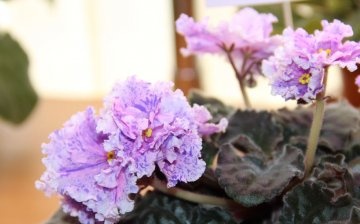
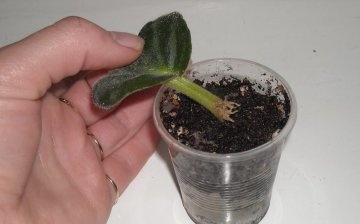








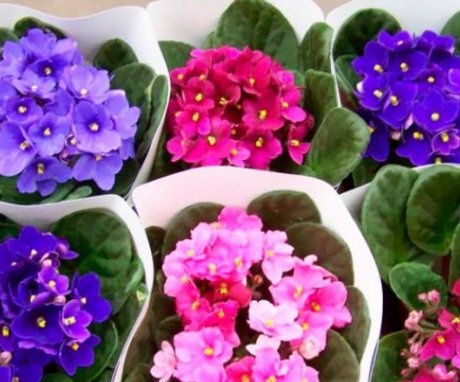
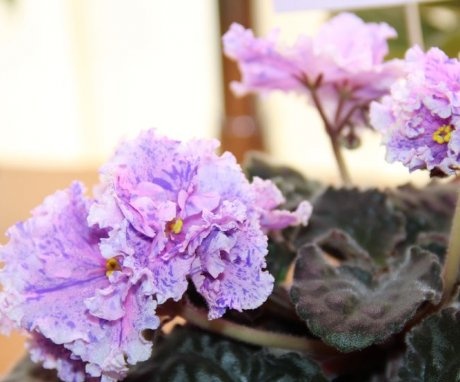
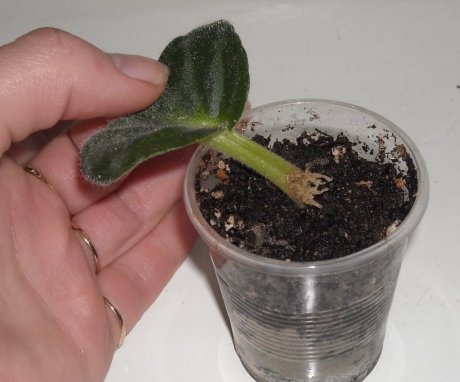
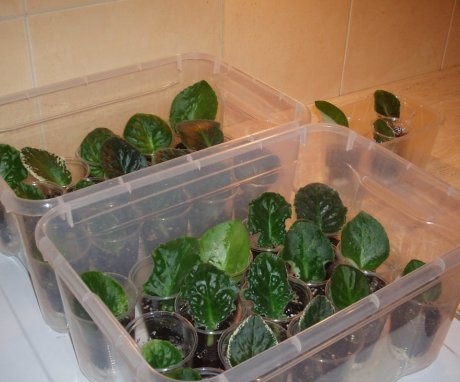
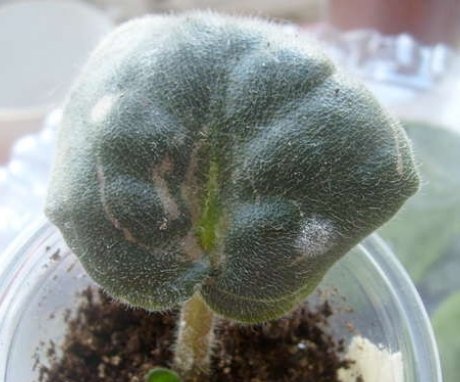
My mother usually puts such violet leaves in water for a week, until a small root grows out of the leaf, and then sows it into the ground, but this option may not work for everyone, but I saw that she did that.
Well, what what, but with the rooting of violets from the leaves, there have never been any problems at all. We pinch off, put the leaf in a glass of water for a week or two and then plant it in a pot. 100% survival rate!